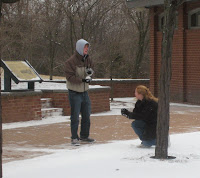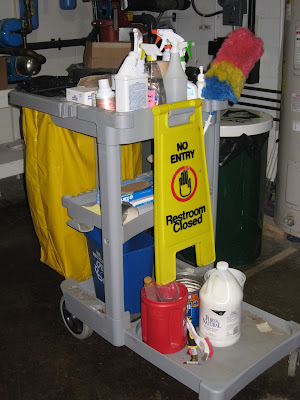Two of the things that have secured Montgomery C. Meigs place in design history are the much despised 1881 U.S. Cavalry helmet...(modeled by yours truly)
and the much beloved Civil War soldiers pension building, now the National Building Museum in Washington D.C.

Designed in 1881 by Civil War Quartermaster General and later civil engineer, Montgomery C. Meigs, the Pension Building (Now the National Building Museum) is one of the landmark buildings of our nation's capitol.
This now cherished building was originally ridiculed as Meigs' "red barn". The Red brick facade of the edifice was so at odds with the marble and alabaster of Washington DC that it was viewed by many as an eyesore.
Fortunately time, and good taste prevailed, and we are left today with a masterpiece of engineering and asthethics. The pension building is, for my money, one of the most beautiful buildings in Washington City.
The building served as the repository of all Civil War veteran's pensions claims into the 1940s and has more recently become the site of inauguaral balls, state occaisions, and now, the Smithsonian Craft shows.
 Here is the Haughty Monty Meigs who delighted in confiscating the Arlington home of Robert E. Lee to inter the dead of the first Manassas on the grounds of "Mars Robert's" slaveholding.
Here is the Haughty Monty Meigs who delighted in confiscating the Arlington home of Robert E. Lee to inter the dead of the first Manassas on the grounds of "Mars Robert's" slaveholding.
But a closer look at Meig's very, very sad countenance provides us with a hint of his deep bitterness toward the traitorious Southland...
 his much beloved son, killed in battle was a loss that devastated the general.
his much beloved son, killed in battle was a loss that devastated the general.
 The bronze monument of the younger Meigs at Arlington National Cemetery is located directly behind that of his father.
The bronze monument of the younger Meigs at Arlington National Cemetery is located directly behind that of his father.
Montgomery Meigs transended that loss to go on to be one of the most influential post-war generals of the United States Army. He would prevail over his own personal loss to embrace the plight of all disabled Union veterans and design for them a revolutionary records center in the nation's capitol; the pension building.

An exterior frieze wrapping around the entire building depicts a parade of Civil War military units.The frieze was designed by Bohemian-born sculptor Caspar Buberl (1834-1899). The frieze is made of terra-cotta and measures 1,200 feet long, 3 feet high.

 It salutes the foot slogging infantry,
It salutes the foot slogging infantry,
 The cavalry,
The cavalry,
 the hard working artillery,
the hard working artillery,
 our Navy,
our Navy,

Meig's own Quartermaster Corps,
 and the halt, lame, and wounded to whom this magnificent edifice is dedicated.
and the halt, lame, and wounded to whom this magnificent edifice is dedicated.

and the much beloved Civil War soldiers pension building, now the National Building Museum in Washington D.C.

Designed in 1881 by Civil War Quartermaster General and later civil engineer, Montgomery C. Meigs, the Pension Building (Now the National Building Museum) is one of the landmark buildings of our nation's capitol.
This now cherished building was originally ridiculed as Meigs' "red barn". The Red brick facade of the edifice was so at odds with the marble and alabaster of Washington DC that it was viewed by many as an eyesore.
Fortunately time, and good taste prevailed, and we are left today with a masterpiece of engineering and asthethics. The pension building is, for my money, one of the most beautiful buildings in Washington City.
The building served as the repository of all Civil War veteran's pensions claims into the 1940s and has more recently become the site of inauguaral balls, state occaisions, and now, the Smithsonian Craft shows.
 Here is the Haughty Monty Meigs who delighted in confiscating the Arlington home of Robert E. Lee to inter the dead of the first Manassas on the grounds of "Mars Robert's" slaveholding.
Here is the Haughty Monty Meigs who delighted in confiscating the Arlington home of Robert E. Lee to inter the dead of the first Manassas on the grounds of "Mars Robert's" slaveholding.But a closer look at Meig's very, very sad countenance provides us with a hint of his deep bitterness toward the traitorious Southland...
 his much beloved son, killed in battle was a loss that devastated the general.
his much beloved son, killed in battle was a loss that devastated the general. The bronze monument of the younger Meigs at Arlington National Cemetery is located directly behind that of his father.
The bronze monument of the younger Meigs at Arlington National Cemetery is located directly behind that of his father.Montgomery Meigs transended that loss to go on to be one of the most influential post-war generals of the United States Army. He would prevail over his own personal loss to embrace the plight of all disabled Union veterans and design for them a revolutionary records center in the nation's capitol; the pension building.

An exterior frieze wrapping around the entire building depicts a parade of Civil War military units.The frieze was designed by Bohemian-born sculptor Caspar Buberl (1834-1899). The frieze is made of terra-cotta and measures 1,200 feet long, 3 feet high.

 It salutes the foot slogging infantry,
It salutes the foot slogging infantry, The cavalry,
The cavalry, the hard working artillery,
the hard working artillery, our Navy,
our Navy,
Meig's own Quartermaster Corps,
 and the halt, lame, and wounded to whom this magnificent edifice is dedicated.
and the halt, lame, and wounded to whom this magnificent edifice is dedicated.
The National Building Museum ,nee, the Pension building is one of our nation's premier treasures and I highly recommend a visit.
I think you'll like it.
Looking toward spring,
Your friend,
Ranger Mannie





















